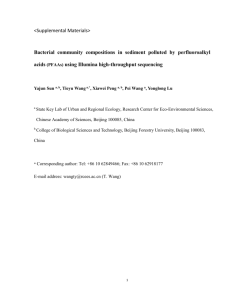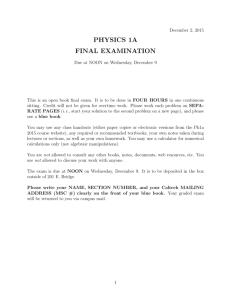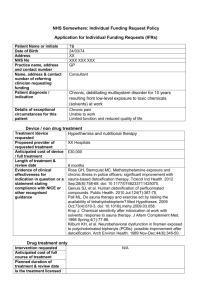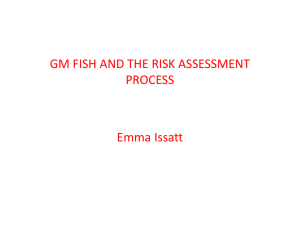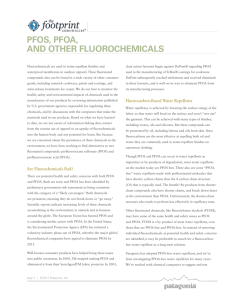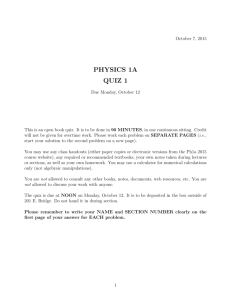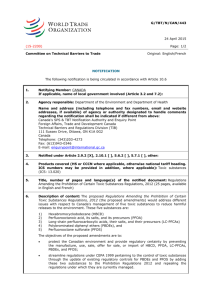2015.06.10 Yasuhirro Kanda powerpoint
advertisement
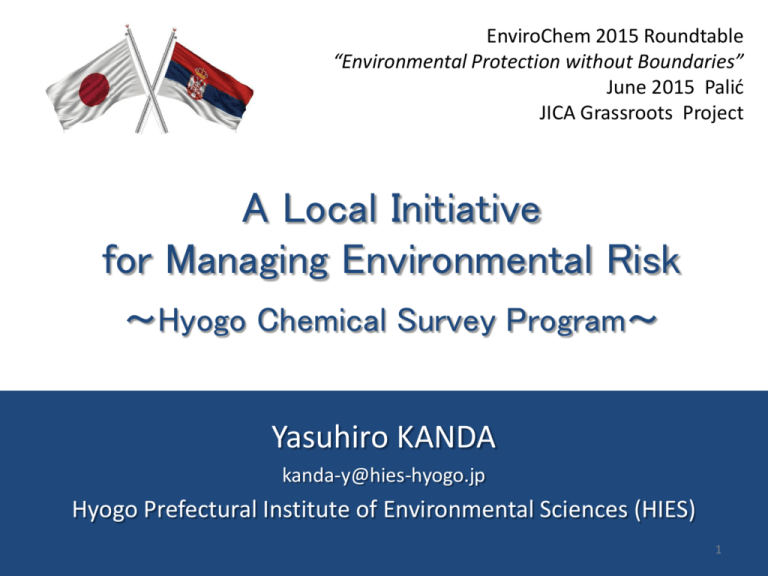
EnviroChem 2015 Roundtable “Environmental Protection without Boundaries” June 2015 Palić JICA Grassroots Project A Local Initiative for Managing Environmental Risk ~Hyogo Chemical Survey Program~ Yasuhiro KANDA kanda-y@hies-hyogo.jp Hyogo Prefectural Institute of Environmental Sciences (HIES) 1 Screening of Chemicals Commercially available chemicals Chemicals which might have high risks Controlled Chemicals which are monitored by law or upon requests of national government There are a lot of chemicals left, which might have high risks and need to be monitored. 2 Risk Assessment Risk = Hazards x Exposures “Hazards” depend on nature of the chemical. “Exposures” have four major routes: skin absorption, inhalation, ingestion and injection. Concentration in the environment is a major factor of exposures, and different from local to local, depending on whether there is a factory who produces, uses or disposes the chemical in a nearby area. This locality of concentration motivates local governments to take an initiative. MOEJ 3 Hyogo Prefecture Hyogo Prefecture Population: 5.4 million Area: 8,400 km2 http://kobe.travel.coocan.jp/ 4 Continuous Monitoring Sites in Hyogo Prefecture Air Pollution Monitoring Stations Water Pollution Monitoring Points 5 National government’s surveys on chemicals Three types of surveys: 1. Initial Environmental Survey 2. Detailed Environmental Survey 3. Environmental Monitoring Whether the chemical exists in the environment or not On the chemicals which found to exist in the environment On POPs or POPs candidate chemicals Percentage of the detection in the environment: Survey results (FY1974-FY2012) 6 Hyogo Chemical Survey Program Purposes are to grasp the situation of chemicals, of which emission standards do not exist, and give guidance to the emitter, and contribute to safety and security of residents. Monitoring is conducted on some target chemicals in water, sediment and air of Hyogo on a three year cycle. FY2009-2011 Target PFOA, PFOS, PBDE, Chemicals HBCD, TBBPA, FTOH FY2012-2014 PCN, HCBD, PFOA FY2015UV-320, UV-326, UV-327, UV-328, PFOA Expert Committee evaluates the survey results, and gives advices to the government. Information disclosure is made by the government via press release and web. Chemical analysis is conducted by Hyogo Prefectural Institute of Environmental Sciences (HIES). Budget is about US$ 5,000 /year. 7 Hyogo Chemical Survey FY2009-2011 Target chemicals: PFOA, PFOS, PBDE, HBCD, TBBPA, FTOH Environmental Media (Number of samples) 2009 2010 River Water(8) Sampling Site (Number of samples) Monitored Chemicals Ina(4), Muko(2), PFOA, PFOS, PBDE, HBCD, TBBPA Kako(2) PFOA Ground water(3) Kako(3) PFOA Air(3) Hanshin area(3) PFOA, PFOS, PBDE, HBCD, TBBPA, FTOH River Water(8) Kako(5), Hokkesantani(2),Kise(1) PFOA, PFOS, PBDE, HBCD, TBBPA Ground Water(17) Kako(17) Effluent Water(2) Kako(2) Sediment(3) Kako(1), Hokkesantani(1), Kise(1) PFOA, PFOS, PBDE, HBCD, TBBPA Air(2) Eastern Harima Area (1), Northern Harima Area(1) Eastern Harima PFOA, PFOS PFOA, PFOS PFOA, PFOS, PBDE, HBCD, TBBPA, FTOH8 Hyogo Chemical Survey FY2009-2011 (continued) Environmental Media (Number of samples) 2011 Sampling Site (Number of samples) Monitored Chemicals River Water(9) Ibo(2), Chikusa(2), Sumoto(4), Mihara(1) PFOA, PFOS, PBDE, HBCD, TBBPA Sediment(4) Ibo(1), Chikusa(1), Sumoto(1), Mihara(19 PFOA, PFOS, PBDE, HBCD, TBBPA Air(2) Western Harima area(1), Awaji area(1) PFOA, PFOS, PBDE, HBCD, TBBPA, FTOH Ground water(3) Eastern Harima area (3) PFOA, PFOS, FTOH Effluent water(1) Eastern Harima Area (1) PFOA, PFOS, FTOH Follow up survey Results: • FY2010 survey found a relatively high PFOA from groundwater in Eastern Harima area. The government identified a company who uses water repellant material, which was contaminated with FTOH: precursor of PFOA. The government gave an administrative guidance to the company, and the company changed the material. • FY2011 survey found a bit high FTOH from air in Western Harima. 9 The government identified a company, and gave an administrative guidance. Hyogo Chemical Survey FY2012-2014 Target chemicals: PCN, HCBD, PFOA Environmental Media (Number of samples) 2012 Sampling Site (Number of samples) Monitored Chemicals River Water(6) Ina(2), Kanzaki(2), Muko(2) PCN, HCBD Sediment(2) Kanzaki(1), Muko(1) PCN, HCBD Air(3) Hanshin area(3) PCN, HCBD Ground Water (3) Eastern Harima area (3) PFOA Effluent Water (1) Eastern Harima area (1) PFOA River Water(5) Kako(3), Hokkesantani(1), Kise(1) PCN, HCBD Sediment(3) Kako(1), Hokkesantani(1), Kise(1) PCN, HCBD Air(2) Eastern Harima area(2) PCN, HCBD Ground Water (3) Eastern Harima area(3) PFOA Effluent Water (1) Eastern Harima area(1) PFOA Follow up survey 2013 Follow up survey 10 Hyogo Chemical Survey FY2012-2014 (Continued) Environmental Media (Number of samples) 2014 Sampling Site (Number of samples) Monitored Chemicals River Water(6) Ibo(2), Chikusa(2), Sumoto(1), Mihara(1) PCN, HCBD Sediment(4) Ibo(2), Chikusa(2), Sumoto(1), Mihara(1) PCN, HCBD Air(2) Western Harima area(1), Awaji area(1) PCN, HCBD Follow up survey Ground Water (2) Eastern Harima area (2) PFOA Effluent Water (1) Eastern Harima area (1) PFOA Follow-up survey results 0.6 μg/L 0.0 PFOA in ground water 2010 winter-2014 winter 8 μg/L PFOA in effluent water 2010 winter-2014 winter 0 After the company changed the material, PFOA concentration 11 dropped sharply. However, contamination still remains. Hyogo Chemical Survey FY2015Target chemicals: UV-320, UV-326, UV-327, UV-328, PFOA Environmental Media (Number of samples) 2015 Sampling time/area Chemicals to be monitored Water(6) two times a year (summer and winter) UV-320, UV-326, UV-327, UV-328 Sediment(2) one time a year (summer) UV-320, UV-326, UV-327, UV-328 Air(3) two times a year(summer and winter) UV-320, UV-326, UV-327, UV-328 Ground Water (3) Eastern Harima area (3) PFOA Effluent Water (1) Eastern Harima area (1) PFOA Follow up survey Follow up survey is scheduled to continue. 12 Significance of the Hyogo Chemical Survey The Survey contributes To find contaminated place at an early stage. If the survey had not been conducted… MOEJ Hazardous chemicals To develop “risk communications” at a local society. (awareness raising, disaster preparedness) Citizens Experts Companies Media Governments 13 For developing an Environmental Monitoring Project Purposes For what policy are the monitoring results used? - To identify the area still polluted by the NATO bombing - To identify the area polluted by business operators - To confirm the safety of an agricultural area - To strengthen the monitoring network ・・・・・and so on. Target Chemicals Which chemicals have been monitored so far? Which chemicals need to be monitored? Environmental media (air, river water, groundwater, sediment, soil, fish, shellfish, etc.) Can we expect cooperation from the administrator or owner/stakeholder of the environmental media? Number of samples Project organization What sampling frequency and sampling duration should be? Who will organize the project ? Who will play what role? (coordination, budget, sampling, chemical analysis, data analysis, …) How can Japan and international community collaborate with the project? 14 Thank you very much for your attention! 15
